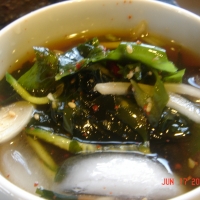To end this weeks posting I have decided to go for a very easy and in many ways addictive recipe. I am sure that you have all heard of ddeokbokki right? If you haven't heard of it, go and check out the recipe I previously posted for ddeokbokki.
Well this recipe today is something similar. Today I will introducing you to ddeokggochi (떡꼬치). It is fried rice cakes on a skewered and lathered in a layer of gochujang. It is a very simple snack and as you can see it is very similar to ddeokbokki, just much more simple.
The dish is very popular with school; aged children as an after school treat and it is also widely sold throughout Korean by street vendors.
Anyway, moving on to the recipe:
Ingredients
20 Sticky Rice Cakes
10 Skewers
Some Oil for Frying
Sauce
3 Tbsp Ketchup
2 Tbsp Red Pepper Paste
2 Tbsp Honey
1 Tbsp Sugar
1 Tbsp Soy Sauce
2 Tbsp Cooking Wine
1 Tbsp Onion Juice
1 Clove Minced Garlic
1 Tbsp Sesame Oil
1 Tbsp Chopped Peanuts
⅛ tsp Black Pepper
Method
1. Boil frozen rice cakes for 1 minute, or until soft. If not frozen, then boil for 30 seconds. After that, drain water, rinse in cold water, and pull them apart.
2. Cut the rice cakes in half.
3. Put 4 or 5 rice cakes on a skewer. You will get about 10 skewered sticky rice cakes.
4. Place the rice cakes in a heated pan with a little oil.
5. Fry until golden brown.
6. While you are frying the rice cakes, make the sauce. Mix all of the sauce ingredients in a pan.
7. Heat the sauce on medium until it boils, stirring occasionally.
8. Coat the fried rice cakes with the sauce.
And there you have it, a quick snack and if you are really desperate you can make a meal out of it.
That will be it from me this week. I will try my best to post again next week, but I do have one final exam. Maybe I can post after the exam, after all the holidays are after that, look forward to it. Until next time stay healthy and happy ^~^






